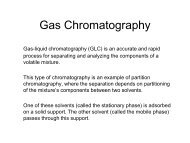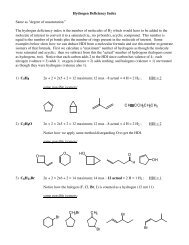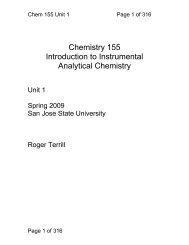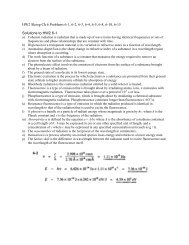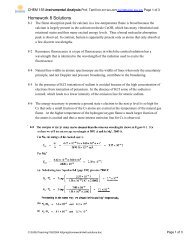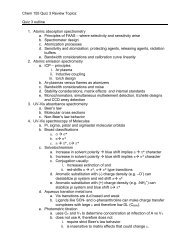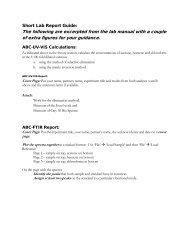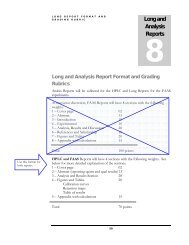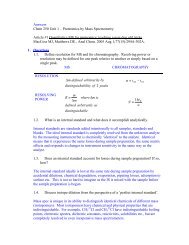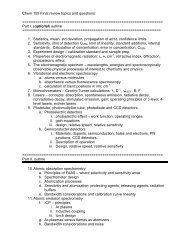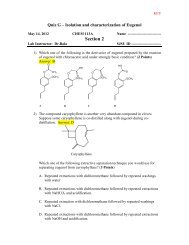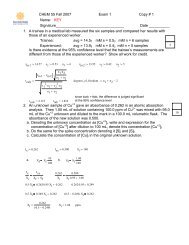Quiz 2 Prep With Some Answers
Quiz 2 Prep With Some Answers
Quiz 2 Prep With Some Answers
You also want an ePaper? Increase the reach of your titles
YUMPU automatically turns print PDFs into web optimized ePapers that Google loves.
Chem 155 Spring 2009 Terrill <strong>Quiz</strong> 2 Page 1 of 2<br />
Name:_______________________<br />
1. Why do gas phase atoms have extremely narrow light absorption and<br />
emission lines (relative to molecules)?<br />
2. Molecular absorbance spectra are more complex than atomic<br />
absorption spectra because the have:<br />
a. _______________ features and<br />
b. _______________ features.<br />
2<br />
2<br />
FYI<br />
h = 6.626x10- 34 Js<br />
c = 2.998x10 8 ms -1<br />
Na = 6.023x10 23 mol -1<br />
λν=c<br />
E = hν<br />
A = -log(T) = εbC<br />
3. A hypothetical molecule has the energy level<br />
diagram to the right. Draw and label three<br />
arrows for each of a-c below to indicate:<br />
a. UV light absorption and (label: UVA)<br />
b. Vibrational Relaxation (label: VRX)<br />
c. Visible light fluorescence (label: FL)<br />
S 1<br />
3<br />
Energy<br />
4. Sketch an energy level diagram for a four<br />
level laser and indicate the following<br />
transitions with arrows:<br />
a. Absorb pump energy (label: A)<br />
b. Intersystem Cross (label: ISC)<br />
c. Laser Emission (label: EM)<br />
d. Relax to ground state (label: RX)<br />
S 0<br />
Use this space to draw 4-level laser energy state<br />
diagram and transition arrows arrows:<br />
4<br />
11
Chem 155 Spring 2008 Terrill <strong>Quiz</strong> 2 Page 2 of 2<br />
5. Complete the following table using: LS= lower state, US = upper state<br />
(referring to states involved in laser emission)<br />
3<br />
Process Name of process Gain or Loss?<br />
hν + __ 2hν + __<br />
hν + __ __<br />
__ LS + hν<br />
6. What is the transmittance at 275 nm of a 1.0x10 -4 M solution of<br />
benzoic acid in cuvette with a pathlength of 1.00 cm? Assume<br />
that the ε 254 = 225 M -1 cm -1 ?<br />
2.5<br />
FYI<br />
h = 6.626x10- 34 Js<br />
c = 2.998x10 8 ms -1<br />
1 eV = 1.602x10 -19 J<br />
Na = 6.023x10 23 mol -1<br />
λν=c<br />
E = hν<br />
A = -log(T) = εbC<br />
7. Connect the following concepts:<br />
Concept<br />
letter<br />
2.5<br />
Min energy to remove electron from a metal. a Plank’s constant<br />
Higher light intensity yields: b More numerous electrons<br />
Higher light frequency yields: c Work function<br />
Slope of photoelectron KE vs light frequency: d Photons<br />
Examined this way, light comprises: e More energetic electrons<br />
8. Fill in the missing column:<br />
Name of EM<br />
regime:<br />
Wavelength Predominant<br />
Excitation<br />
Name of<br />
Spectroscopy<br />
X-Ray 0.1 to 10 nm x-ray absorption<br />
Ultraviolet 180 - 400 Uv or uv-vis<br />
Visible 400-800 Vis or uv-vis<br />
Infrared 2.5-40 μm IR or FTIR<br />
2<br />
P1: 11 P2: 11 Tot: 22
Chem 155 Spring 2008 Terrill <strong>Quiz</strong> 2 Page 1 of 2<br />
Castaneda,Leticia Signature: ______________________ 1<br />
1. Define the following:<br />
a. Work Function of a metal<br />
b. Stokes Shift<br />
FYI<br />
h = 6.626x10- 34 Js<br />
c = 2.998x10 8 ms -1<br />
Na = 6.023x10 23 mol -1<br />
λν=c<br />
E = hν<br />
A = -log(T) = εbC<br />
2<br />
2. Calculate the approximate wavelength of light, in nm, that is capable of<br />
breaking a carbon-carbon bond with an energy of 348 kJ / mol.<br />
2<br />
3. No calculations are necessary for this exercise. A hypothetical molecule has<br />
the following energy level diagram.<br />
a. Draw arrows to indicate<br />
1. IR light absorption<br />
2. UV light absorption and<br />
3. Visible light fluorescence.<br />
b. Sketch a crude absorbance and fluorescence emission spectrum of the<br />
molecule in solution using the axes to the right.<br />
3<br />
2<br />
Energy<br />
S 1<br />
Absorbance or Fluorescence<br />
S 0<br />
200 Wavelength / nm 400<br />
15
Chem 155 Spring 2008 Terrill <strong>Quiz</strong> 2 Page 2 of 2<br />
Castaneda,Leticia 1<br />
4. What is the transmittance at 254 nm of a 1.0x10 -4 M solution of<br />
caffeine in an HPLC detector cell with a pathlength of 0.025 cm?<br />
Assume that the ε 254 = 650 M -1 cm -1 ?<br />
FYI<br />
h = 6.626x10- 34 Js<br />
c = 2.998x10 8 ms -1<br />
1 eV = 1.602x10 -19 J<br />
Na = 6.023x10 23 mol -1<br />
λν=c<br />
E = hν<br />
A = -log(T) = εbC<br />
2<br />
5. Connect the following concepts:<br />
Concept<br />
letter<br />
Minimum energy required<br />
to remove an electron<br />
from a metal.<br />
Higher light intensity<br />
yields:<br />
a<br />
b<br />
Plank’s constant<br />
More numerous electrons<br />
Higher light frequency<br />
yields:<br />
c<br />
Work function<br />
Slope of photoelectron<br />
KE vs light frequency:<br />
d<br />
Photons<br />
Examined this way, light<br />
comprises:<br />
e<br />
More energetic electrons<br />
2<br />
6. Fill in the missing column:<br />
Name of EM<br />
regime:<br />
Wavelength Predominant<br />
Excitation<br />
Name of<br />
Spectroscopy<br />
X-Ray 0.1 to 10 nm x-ray absorption,<br />
fluorescence, xps<br />
Ultraviolet 180 - 400 Uv or uv-vis<br />
Visible 400-800 Vis or uv-vis<br />
Infrared 2.5-40 μm IR or FTIR<br />
2
Chem 155 Spring 2007 Terrill <strong>Quiz</strong> 2 Page 1 of 2<br />
Name: ______________________________<br />
FYI<br />
16<br />
1. Define the following:<br />
a. Photoelectric effect<br />
When irradiated with light of sufficiently short wavelength a metal surface may<br />
emit electrons – this emission of electrons is known as the photoelectric effect.<br />
The kinetic energy of the electrons is equal to hν-Φ, the photon energy minus<br />
the work function of the metal.<br />
b. Fluorescence<br />
When irradiated with light of the proper wavelength an atom, molecule or ion<br />
may absorb a photon, and then re-emit a photon of equal or longer wavelength.<br />
This absorption-re-emission process is called fluorescence or sometimes<br />
phosphorescence if the excited state lifetime is > about 10 -5 s.<br />
2. Calculate the frequency in Hz, the energy in Joules, and the energy in kJ/mol<br />
of an ultraviolet photon with a wavelength of 254 nm.<br />
λν ⋅ c so ν<br />
E<br />
c<br />
λ<br />
=<br />
2.998⋅<br />
10 8 m<br />
⋅<br />
s<br />
= 1.18× 10 15 Hz<br />
254⋅<br />
10 − 9 ⋅m<br />
h⋅ν<br />
so E = 1.18× 10 15 Hz⋅ 6.626⋅<br />
10 − 34 ⋅J⋅s<br />
= 7.819× 10 − 19 J<br />
h = 6.626x10- 34 Js<br />
c = 2.998x10 8 ms -1<br />
Na = 6.023x10 23 mol -1<br />
λν=c<br />
E = hν<br />
A = -log(T) = εbC<br />
2<br />
2<br />
E molar<br />
1kJ<br />
EN ⋅ a ⋅ so Emolar = 7.819⋅<br />
10 − 19 ⋅J⋅6.023<br />
10 23 − 1 1kJ ⋅<br />
⋅ ⋅mol<br />
⋅ = 471 kJ<br />
1000⋅<br />
J<br />
1000J mol<br />
3. No calculations are necessary for this exercise. A hypothetical molecule has<br />
the following energy level diagram.<br />
a. Draw arrows to indicate<br />
1. IR light absorption<br />
2. UV light absorption and<br />
3. Visible light fluorescence.<br />
b. Sketch a crude absorbance and fluorescence emission spectrum of the<br />
molecule in solution using the axes to the right.<br />
3<br />
2<br />
Energy<br />
S 1<br />
Absorbance or Fluorescence<br />
absorption<br />
fluorescence<br />
S 0<br />
200 Wavelength / nm 400
Chem 155 Spring 2007 Terrill <strong>Quiz</strong> 2 Page 2 of 2<br />
Name: ______________________________<br />
4. Convert the following percent transmittances into absorbance:<br />
a. 90 %T<br />
b. 9.0 %T<br />
A<br />
−log( T)<br />
−log( 0.9)<br />
= 0.046<br />
−log( 0.09)<br />
= 1.046<br />
T<br />
%T<br />
100<br />
FYI<br />
h = 6.626x10- 34 Js<br />
c = 2.998x10 8 ms -1<br />
Na = 6.023x10 23 mol -1<br />
λν=c<br />
E = hν<br />
A = -log(T) = εbC<br />
c. 0.090 %T<br />
−log( 0.0009)<br />
= 3.046<br />
2<br />
5. Convert the following absorbances into % transmittance:<br />
a. 0.0010<br />
b. 1.0<br />
%T 100⋅<br />
10 − A<br />
100 ⋅%<br />
⋅10 − 0.0010 = 99.77%<br />
c. 3.0<br />
100 ⋅%<br />
⋅10 − 1.0 = 10%<br />
100 ⋅%<br />
⋅10 − 3.0 = 0.1%<br />
2<br />
6. A solution has an absorbance of 1.87 at 550 nm. Then 5.00 mL of this<br />
solution was pipetted into a 100.0 mL volumetric flask and diluted to the mark<br />
with water. What do you now expect the absorbance to be?<br />
A 1<br />
A 2<br />
ε⋅b⋅C and 1 C 2 ⋅V 2 C 1 ⋅V 1<br />
ε⋅b⋅C 2<br />
so<br />
A 2 C 2<br />
V 1<br />
and C<br />
A 1 C 2 C 1 ⋅ substituting for C<br />
1 V 2<br />
2<br />
V 1<br />
C<br />
A 1 ⋅<br />
2 V 2<br />
A 1 C 1<br />
A 2 V 1<br />
V 1<br />
A<br />
A 1 V 2 A 1 ⋅ = 1.87⋅ 5.00 = 0.0935<br />
2 V 2 100.0<br />
3
CHEM 155 Instrumental Analysis Prof. Terrill DH-007 924-4970 rterrill@jupiter.sjsu.edu Page 1 of 4<br />
Name:<br />
<strong>Quiz</strong> 2 Propagation of error, basic spectroscopy, lasers and PMT’s.<br />
1. Why does a four-level laser require a lower input of pump energy to ‘lase’ (i.e.<br />
achieve net amplification by stimulated emission) than a 3-level laser?<br />
3 pts<br />
2. Which one of the following statements about spectroscopy is false?<br />
a. Electronic spectra are generally much higher frequency than vibrational spectra.<br />
b. Vibrational fine structure appears in electronic spectra.<br />
c. Fluorescence arises from transitions between the ground vibrational state of an<br />
excited electronic state to excited vibrational states of the ground electronic state.<br />
d. Electronic spectra of gas phase atoms comprise broader bands than do spectra<br />
of small gas phase molecules.<br />
e. Absorbance bands originate in transitions from the ground vibrational state of the<br />
ground electronic state to excited vibrational states of excited electronic states.<br />
3. A photomultiplier tube has a quantum efficiency of 0.25 and 10 dynodes each<br />
with a secondary electron yield of 5. What is the gain of this detector in<br />
electrons per incident photon?<br />
3 pts<br />
3 pts<br />
C:\rht\SJSU\Teaching\155\2006A Spring\<strong>Quiz</strong>\2\<strong>Quiz</strong> 2 Error Prop, Materials, Detectors.doc Page 1 of 4
CHEM 155 Instrumental Analysis Prof. Terrill DH-007 924-4970 rterrill@jupiter.sjsu.edu Page 2 of 4<br />
4. Fill in the blanks or make the multiple choice selection:<br />
Arrows that go up<br />
correspond to light<br />
______________ .<br />
Dashed arrows that<br />
go down correspond<br />
to ____________<br />
_____________<br />
(bonus for this one)<br />
Arrows that go<br />
down correspond<br />
to light _________ ,<br />
a process known as<br />
_____________ .<br />
Wavelength:<br />
a. γ-ray<br />
b. x-ray<br />
c. UV<br />
d. Vis<br />
e. NIR<br />
f. IR<br />
g. μ-wave<br />
h. radio<br />
___________<br />
___________<br />
Wavelength:<br />
a. γ-ray<br />
b. x-ray<br />
c. UV<br />
d. Vis<br />
e. NIR<br />
f. IR<br />
g. μ-wave<br />
h. radio<br />
__________<br />
C:\rht\SJSU\Teaching\155\2006A Spring\<strong>Quiz</strong>\2\<strong>Quiz</strong> 2 Error Prop, Materials, Detectors.doc Page 2 of 4<br />
8 pts
CHEM 155 Instrumental Analysis Prof. Terrill DH-007 924-4970 rterrill@jupiter.sjsu.edu Page 3 of 4<br />
5. Calculate the concentration of the solution that was diluted as follows:<br />
10.00±0.05 mL of 37.5±0.3 mM Fe(NO3)3 was pipetted into a 100.0±0.1 mL<br />
volumetric flask and diluted to the mark.<br />
Calculate the concentration, C2 and the estimated standard error in that<br />
concentration s C2 .<br />
6. A laser beam strikes a diffraction grating at normal incidence and is deflected<br />
at the following angles: 0°, 18.44°, 38.25° and 71.65°. The wavelength of the<br />
laser is 488.0 nm. What is the spacing on the grating in nm?<br />
5 pts<br />
C:\rht\SJSU\Teaching\155\2006A Spring\<strong>Quiz</strong>\2\<strong>Quiz</strong> 2 Error Prop, Materials, Detectors.doc Page 3 of 4
CHEM 155 Instrumental Analysis Prof. Terrill DH-007 924-4970 rterrill@jupiter.sjsu.edu Page 4 of 4<br />
Propagation of Error:<br />
Multiplication/division rule:<br />
Addition/subtraction rule:<br />
c±σ c<br />
If: a b±σ b + c±σ c − d±σ d If: a b±σ b ⋅<br />
d±σ d<br />
2 2 2<br />
Then: σ a σ b + σ c + σ d Then:<br />
Signals:<br />
σ a<br />
a<br />
2 2<br />
σ b σ c<br />
b 2 +<br />
c 2<br />
+<br />
σ d<br />
2<br />
d 2<br />
Electromagnetic (EM) Radiation:<br />
Constants:<br />
Equations:<br />
h 6.626⋅10 34 js ⋅ Plank Constant<br />
c 3.00⋅10 8 ms ⋅<br />
− 1 Speed of light in vacuum<br />
k 1.38⋅10 23 jK ⋅<br />
− 1 Boltzmann Constant<br />
Na<br />
− 1<br />
6.022⋅10 23 mol Avogadro's Number<br />
Joule 1.602⋅10 19 ⋅eV<br />
E h⋅ν<br />
Photon Energy<br />
λν ⋅<br />
c<br />
Velocity of light in vacuum<br />
λ max ⋅T<br />
310 ⋅<br />
6<br />
nm⋅K<br />
Wien Displacement<br />
Law for Blackbodies<br />
Interactions of EM Radiation with Matter:<br />
c<br />
c medum<br />
n Refractive index<br />
medium<br />
n 1 ⋅sin( θ 1 ) n 2 ⋅sin( θ 2 )<br />
I R ( n 2 − n 1 ) 2<br />
I o ( + ) 2 Fresnel Formula for Normal<br />
E e<br />
n 2 n 1<br />
h⋅ν<br />
− φ<br />
Snell's Law of Refraction<br />
Incidence Reflection<br />
Photoelectric effect<br />
Diffraction and Monochromators:<br />
n⋅λ<br />
d⋅sin( θ)<br />
n⋅λ<br />
d⋅( sin( r) + sin()<br />
i )<br />
Grating Equation - normal incidence<br />
Grating Equation<br />
5 pts<br />
PMT Gain:<br />
G = φα n<br />
C:\rht\SJSU\Teaching\155\2006A Spring\<strong>Quiz</strong>\2\<strong>Quiz</strong> 2 Error Prop, Materials, Detectors.doc Page 4 of 4<br />
14pts



